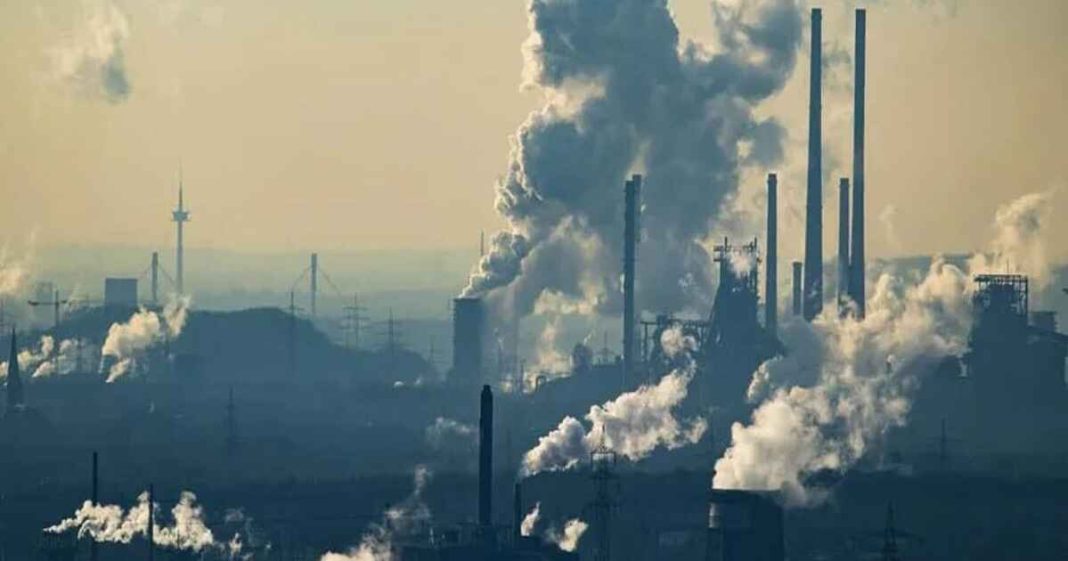Shahid Sattar & Noreen Akhtar|
Climate change is the worst catastrophe mankind is experiencing around the globe. The poorer South is suffering the increasing vulnerability to climate change and countries such as Pakistan with little contribution to global GHG emissions are among the top listed sufferers. The recent country-wide floods are evidence of Pakistan bearing someone else’s emissions burden. The global GHG emissions data indicate that Pakistan contributes around 1% to these emissions. Energy and agriculture are the main sectors responsible for most of the emissions as 46% of emissions come from the energy sector and 41% from agriculture.
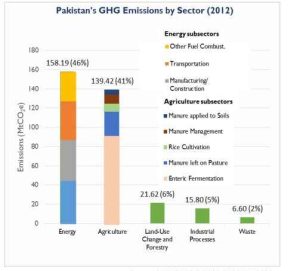
The industry sector contributes 5% to the country’s GHG emissions while the textile industry contributes 9.5% for both gate-to-gate and cradle-to-gate categories. Thus, the textile industry contributes around 9.5% to the country level and 0.095% to global GHG emissions.
Read more: Climate change in Pakistan: An undeniable reality
Pakistan’s per capita GHG emissions with an overall impact of 1% have increased at an alarming rate. For instance, its emissions have increased by 87% from 1990 to 2012 while its textile export competitor Bangladesh’s emissions grew by 59% for the same time period and India’s emissions grew by 180% from 1990-2014. Although, Pakistan’s emissions are far lower than global and India’s emissions, the country still needs to make significant efforts in reducing its carbon footprint, especially in its agriculture and energy sectors.
To make the agriculture sector sustainable, the use of fertilizers can be reduced, organic seeds can be farmed and water pumping techniques can be more environmentally friendly. Also, as the textile sector heavily relies on local cotton production for its functioning, it can support sustainable agriculture by assisting farmers in improving soil health as a carbon sink and fertilizer management via financial and technical backup. The energy sector also needs transformation towards renewable energy sources.
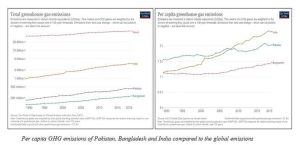
Pakistan’s response to overcome GHG emissions
Pakistan’s increasing GHG emissions, however, should not lead the world to overlook its significant efforts toward fulfilling the global climate change and environmental protection vows. For instance, Pakistan ratified crucial international climate actions including UNFCCC and Kyoto Protocol.
Moreover, in response to the country-wide disasters in 2010 and 2011, the Government of Pakistan (GoP) developed National Climate Change Policy (NCCP) as a major guideline to ensure climate change mitigation and adaptation in the country. NCCP was revised and updated in 2021 to ensure sustained economic growth by integrating climate change at the policy level and fulfilling SDG implementation in every sector.
Pakistan’s continuous efforts in overcoming GHG emissions also include updating the Nationally Determined Contributions (NDCs) in 2021. Despite Pakistan’s financial needs remaining high, the updated NDCs aim to decarbonize its economy and enhance its climate resilience by cutting 50% emissions, shifting to 60% renewable energy, and targeting 30% electric vehicles by 2030.
Pakistan’s textile industry has also shown tremendous efforts in reducing its carbon footprint. Some of the leading textile mills such as Sarena Textiles and Crescent Bahuman Textiles have significantly reduced their emissions by using renewable energy sources and enhanced carbon sequestration via nature-based solutions such as plantations.
Sarena Textiles has reduced 76% of coal usage and currently saves 29% energy from equipment and 33% water via innovative technologies. Crescent Bahuman Textiles also aims to reduce GHG emissions via green initiatives by enhancing carbon sequestration, reducing water consumption by around 50%, and increasing rainwater harvesting.
Although there is a lot of scope for Pakistan’s textile industry to enhance its monitoring as well as environmental compliance, its increasing contribution to mitigating climate change is a positive indication of the country’s efforts in decarbonizing its economy.
Read more: Climate change crisis: What should Pakistan do to save itself?
Pakistan’s increasing annual GHG emissions compared to the annual GDP growth are of high concern, especially for the top GHG-emitting energy, agriculture, and industry sectors. Pakistan needs to overcome the gap between policy formulation and implementation via the effective functioning of its NCCP and NDCs 2021. This requires tremendous financial and technical support from the country. However, even if Pakistan goes completely green, the global North will be emitting far more carbon and Pakistan will continue experiencing the burden of other’s emissions.
Thus, the global North needs to come forward and support Pakistan in making its economic growth sustainable. One way could be the renewal of the GSP+ status in 2023. As 18% of Pakistan’s GDP rely upon the industry sector, the GSP+ renewal will be a golden opportunity for the country to comply with the already ratified mandatory international conventions in its industry sector and boost its economy sustainably.
Pakistan and global water consumption
Global water consumption is another crucial global environmental challenge associated with the industry sector. Both water quality and quantity are reducing around the globe and the current situation is getting worse. It is predicted that by 2050, 57% of the global population will live in areas that suffer water scarcity for at least one month each year. Pollution and untreated wastewater from industries are considered one of the major causes of high water consumption and quality deterioration. The global water consumption data indicates that 19% of the total global water withdrawal is used for industrial purposes.
In the case of Pakistan, the entire industry sector consumes 23% of the total water withdrawn at the country level of which 49% is consumed by the textile sector alone for both the cradle-to-gate and gate-to-gate categories. This means that the textile sector contributes to around 11.3% of the total country-level industrial water consumption and 2.15% of the global industrial water consumption.
Pakistan was ranked 160th in the ratio of water withdrawals to water resources in 2017. Agriculture, domestic usage, and industry are considered the largest water consumers in the country.
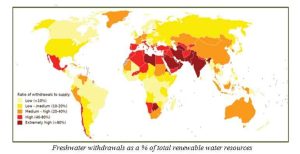
Climate change, poor water management, and increasing water pollution especially from the industrial sector are other major causes further deteriorating the already exhausting water resources in Pakistan. For instance, climate change is causing water flow decline, extreme droughts, and unpredictable floods thus resulting in freshwater pollution.
Read more: Why Pakistan’s water crisis needs urgent attention?
Also, manufacturing industries are not only consuming large volumes of freshwater, but they are also creating huge amounts of untreated wastewater with hazardous chemicals. Unfortunately, only 1% of the domestic and industrial wastewater in Pakistan is treated and 64% is discharged into rivers or the Arabian Sea, while other neighboring countries such as Bangladesh treat 17% of its wastewater. These causes along with the unsustainable groundwater consumption for agricultural and industrial use are causing a sharp decline in per capita renewable water resource availability in Pakistan.
In 2017, Pakistan had 1,253 m³/person/year of renewable water while Bangladesh has 7,451 m³/person/year and India had 1427 m³/person/year of renewable water resources. This indicates that Pakistan’s available water resources are declining at an alarming rate. Thus, the giant water consumers including both agriculture and industry can enhance water use efficiency by adopting modern and efficient water conservation options to protect Pakistan from becoming a water-scarce country.
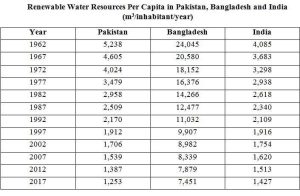 Pakistan needs to implement significant efforts toward sustainable and integrated water management. Fortunately, the development and management of water resources have already received considerable attention. For instance, the approval of the first-ever National Water Policy Package shows a historic milestone. The policy addresses all relevant issues regarding water resource management and the role of relevant stakeholders.
Pakistan needs to implement significant efforts toward sustainable and integrated water management. Fortunately, the development and management of water resources have already received considerable attention. For instance, the approval of the first-ever National Water Policy Package shows a historic milestone. The policy addresses all relevant issues regarding water resource management and the role of relevant stakeholders.
Moreover, Recharge Pakistan is one of the major ventures related to water security and management. It aims to increase water storage and recharge through wetland and floodplain management via community-based natural resource management and nature-based solutions. Pakistan has also added flood risk mitigation and enhanced water recharge as high-priority actions in its updated NDCs. Pakistan’s updated NCCP focuses on integrated water resource management, capacity building for water management, and awareness raising.
Pakistan’s textile industry has also shown significant improvement toward sustainable management of water resources, although efforts need to be enhanced. For instance, Sarena Textiles through its green initiatives has reduced 33.3% water consumption and their average daily water saving is around 1380 m3. Crescent Bahuman Textiles has set its goals to reduce 50% of water consumption via its green initiatives and Crestex is aiming to reduce and reuse 25% of water as part of its zero liquid discharge goals.
Read more: Pakistan’s Textile Exports: Growth and Trends
Despite having the world’s largest glaciers, Pakistan is among the world’s 36 most water-stressed countries. With the rapidly increasing population, water demand is projected to surpass the supply. This coupled with strained relations with the country’s neighbors over transboundary water resources, the growing water crisis is posing a threat to the country’s future sustainability.
The current progress needs to be enhanced and immediate coordinated planning and implementation are required to avert the disaster. In this regard, crucial stakeholders including the textile industry need to efficiently monitor their water withdrawal, usage, and pollution patterns keeping in mind international wastewater directives. Moreover, international stakeholders such as top export destinations can support the industry sector enhance its technical capability in water management via training and resource allocation. The industry should not rely upon extrinsic pressure to bring sustainable change. It should rather come from intrinsic values and a desire for a better change.
Pakistan and global land-use change
Land use change is another global environmental challenge posing significant impacts on the natural environment due to human activities. It is the process of transforming the natural landscape, usually associated with the functional value of land for economic activity. In the case of Pakistan, the important crops being cultivated include wheat, rice, sugarcane, maize, and cotton. Among the most vital to the country’s economy are sugarcane and cotton.
During 2020-2021, around a 12% increase in the cultivated area was observed for sugarcane. Cotton on the other hand was cultivated on 2,079 thousand hectares as compared to last year’s sown area of 2,517 thousand hectares showing a 17% contraction in the cultivated area. The factors contributing to this decline are biotic stresses due to pests, abiotic stresses due to climate change, and poor agricultural practices. This data indicates that land use patterns in crop cultivation in Pakistan are more associated with sugarcane farming than cotton cultivation.
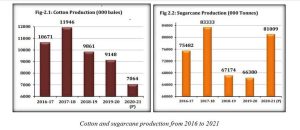
Globally, 2.5% of the cultivable land is used to cultivate cotton. However, with the increasing demand for fabrics and changing human lifestyle, land use for cotton production is also increasing. In Pakistan, land use for the textile industry is mainly associated with cotton cultivation covering 15% of the cultivated area while in its neighboring country Bangladesh, only around 1% cultivable area is used to grow cotton. This indicates that around 0.38% of the global land use for cotton cultivation takes place in Pakistan.
Although cotton production has declined in the past few years, Pakistan is still among the largest cotton producers globally as it is naturally a more drought-resistant crop. Thus, if Pakistan aims to increase its cotton production, the associated land-use change impacts need to be given a high priority. For instance, the expansion of cotton cultivation might cause the loss of native habitats and exacerbate the spread of invasive species. Moreover, the increasing use of pesticides might cause a loss in soil structure and natural carbon sinks.
Read more: Cotton: Handling the White Gold Crisis of Pakistan
Multiple initiatives around Pakistan have been observed to reduce the impacts of land use change associated with cotton cultivation. For instance, Better Cotton Program launched in 2009 aims to grow cotton more sustainably and improve the livelihoods of millions of farmers. As cotton cultivation is getting immensely affected by unpredictable weather patterns due to climate change, this is leading to increased pests thus reducing its production and increasing pesticide use. Better Cotton Program in this regard is supporting farmers to use environmentally friendly fertilizers and pesticides and improve water use practices.
Moreover, the Center for Agriculture and Bioscience International (CABI) has implemented its Better Cotton project to train farmers on the Better Cotton Standard System and good agricultural practices. The project aims to reduce pesticide and water use in cotton cultivation, improve yields, and ultimately the livelihoods of farmers (CABI 2022a). CABI’s Sustainable Organic Cotton Production project aims to support organic cotton production and contribute to the long-term availability of non-GM cotton seeds and organic inputs of farmers with a self-sustaining approach. Also, Interloop has initiated its Looptrace platform to allow supply chain stakeholders to track, trace and access transparent raw material information to meet shared sustainability goals.
Pakistan’s textile industry is also committed to enhancing cotton cultivation in a sustainable manner and reducing the associated land use change impacts. For instance, Pakistan’s largest textile trade association APTMA (All Pakistan Textile Mills Association) signed an agreement with the Better Cotton Initiative (BCI) to boost cotton export with environmental and social compliance. APTMA has also hired experts who are working on enhancing cotton production in a sustainable manner. Moreover, ICA (International Cotton Association) has agreed with APTMA to strengthen its support for the cotton needs of the textile industry (Global Village Space 2022).
Read more: Dealing with the cotton needs of Pakistan’s textile industry
Climate change has been proven to be devastating for Pakistan’s cotton cultivation and textile industry this year. The current country-wide severe flooding and rains have intensified the already declining cotton yield and destroyed more than 45% of the country’s cotton crops. The global community in this regard needs to come forward to share the burden of their emissions and support Pakistan to enhance its textile exports sustainably.
What needs to be done?
In conclusion, GHG emissions, increasing water consumption, and land use changes are some of the major global environmental challenges associated with Pakistan’s textile industry. Pakistan needs to increase the pace of its monitoring and compliance to overcome these challenges to enhance climate change resilience but also, to stay in line with its regional export competitors.
Furthermore, the global community needs to support the current initiatives and assist Pakistan to decarbonize its economy. The increasing GHG emissions, deteriorating water quality, and quantity and land-use changes in Pakistan need special consideration from both the authorities and the sectors highly reliant on local resources. The textile industry, for instance, needs to monitor its wastewater generation and implement reduce–recycle–reuse techniques. Also, the top textile export destinations can also support the industry in enhancing its technical and financial capability to reduce water consumption and pollution. Additionally, better cotton standards and sustainable initiatives need to be implemented.
Pakistan is a top sufferer of climate change. Every time a climate event hits the country, its development is pushed decades back. Thus, Pakistan needs to enhance its social and environmental compliance to make its economic development sustainable and the global community needs to support this development, especially in this era of harsh climatic events.
Read more: Climate injustice and global apathy: The case of Pakistan
The article has been written by Mr. Shahid Sattar, Secretary General, APTMA, and Noreen Akhtar, Research Associate – Sustainable Development of APTMA’s newly established Sustainable Development Department. The views expressed in the article do not reflect the editorial policy of Global Village Space.


